
Leopard frog is a generic name used to refer to various species in the true frog genus Lithobates. They all have similar coloration: brown or green with spots that form a leopard pattern. They are distinguished by their distribution and behavioral, morphological, and genetic differences. The range of the various species of leopard frogs extends from the Hudson Bay in Canada, throughout the United States, throughout Mexico and other parts of Central America, and possibly the very northern section of South America.

Lithobates pipiens or Rana pipiens, commonly known as the northern leopard frog, is a species of leopard frog from the true frog family, native to parts of Canada and the United States. It is the state amphibian of Minnesota and Vermont.

The Rio Grande leopard frog is a species of aquatic frog native to the southern United States in Texas and New Mexico, and south through Mexico and Central America. It is also sometimes referred to as the Mexican leopard frog. The epithet berlandieri is in honor of the naturalist Jean Louis Berlandier, who worked for the Mexican government on one of the first biological surveys of Texas.

The Vegas Valley leopard frog is a species of frog previously declared extinct. It once occurred in the Las Vegas Valley, as well as Tule Springs, Clark County, southern Nevada, United States of America, at elevations between 370 and 760 m. It was believed to be the only frog endemic to the United States to have become extinct in modern times.
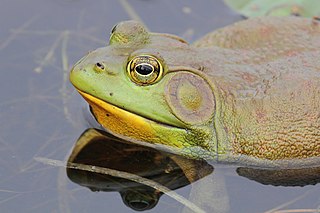
Lithobates is a genus of true frogs, of the family Ranidae. The name is derived from litho- (stone) and the Greek bates, meaning one that treads on rock, or rock climber.
Gunther's robber frog, Günther's robber frog, or Guerreran robber frog is a species of frog in the family Craugastoridae. It is endemic to the Sierra Madre del Sur in the Guerrero state, Mexico. Its natural habitats are pine, oak, and pine-oak forests with plenty of leaf-litter on the ground. It is a relatively common species but declining and threatened by habitat loss and disturbance.
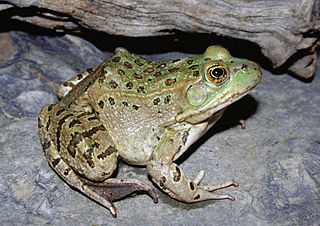
The Chiricahua leopard frog is a species of frog in the family Ranidae, the true frogs.
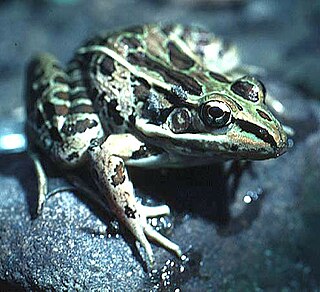
Forrer's grass frog or Forrer's leopard frog, Lithobates forreri, is a species of frog in the family Ranidae found in Mexico and Central America through Guatemala, El Salvador, Honduras, and Nicaragua to Costa Rica. It is a widespread and common frog found in lowland and seasonal tropical forests. It can also adapt to man-made habitats such as flooded agricultural lands and other water content systems. Reproduction requires permanent pools and lagoons.
Lemos-Espinal's leopard frog is a species of frog in the family Ranidae endemic to the Sierra Madre Occidental of southwestern Chihuahua in northern Mexico. Its natural habitats are pine-oak forests. It is threatened by habitat loss.
The Northwest Mexico leopard frog is a species of frog in the family Ranidae endemic to Mexico. This predominantly aquatic frog inhabits temporary or permanent pools in shrublands and mesquite forests. It might be threatened by droughts.
The big-footed leopard frog or bigfoot leopard frog, is a species of frog in the family Ranidae endemic to western central Mexico where it is found in the Nayarit, Jalisco, Michoacan, and Guanajuato states.
The island leopard frog or Little Corn Island frog is a species of frogs in the family Ranidae, endemic to Little Corn Island off the Caribbean coast of Nicaragua. It is locally known as rana leopardo isleña.

The Montezuma leopard frog, Lithobates montezumae, is a species of frog in the family Ranidae endemic to Mexico. Its natural habitats are pine-oak or oak forests above 2,000 m (6,600 ft) asl but it can also survive in moderately altered habitats. It breeds in lakes and big pools. It is potentially threatened by habitat loss and introduced predators. It is also collected for human consumption.
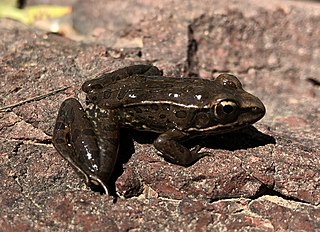
The transverse volcanic leopard frog is a species of frog in the family Ranidae endemic to the southern edge of the Mexican Plateau, Mexico. Its natural habitats are pine-oak forests and mesquite grasslands near lakes, pools or slow-flowing streams. It is threatened by habitat loss.

The showy leopard frog is a species of frog in the family Ranidae endemic to Mexico.

The Peralta frog, or montane leopard frog, Lithobates taylori, is a species of frog in the family Ranidae found in Costa Rica and Nicaragua.
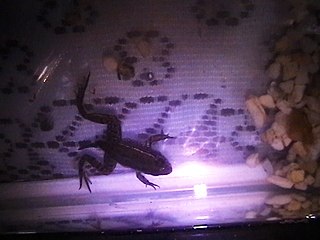
Tlaloc's leopard frog, or rana de Tláloc in Spanish, is a species of frog in the family Ranidae endemic to the Valley of Mexico. It is most likely extinct.
The Lenca leopard frog is a species of true frog found in the Chortis Highlands of southwestern Honduras at altitudes of 1560 to 2080 m. This frog was long thought to be a hybrid between the two lowland species Lithobates brownorum and Lithobates forreri until 2018 when DNA tests proved the highland leopard frogs to be a distinct species. They are smaller in size but have larger heads than the two lowland species, with males growing between 46.6–64.3 mm (1.83–2.53 in) while females grow between 43.7–76.3 mm (1.72–3 in). The Lenca leopard frog is named after the Lenca people, who inhabit the same mountainous region as the frog.













